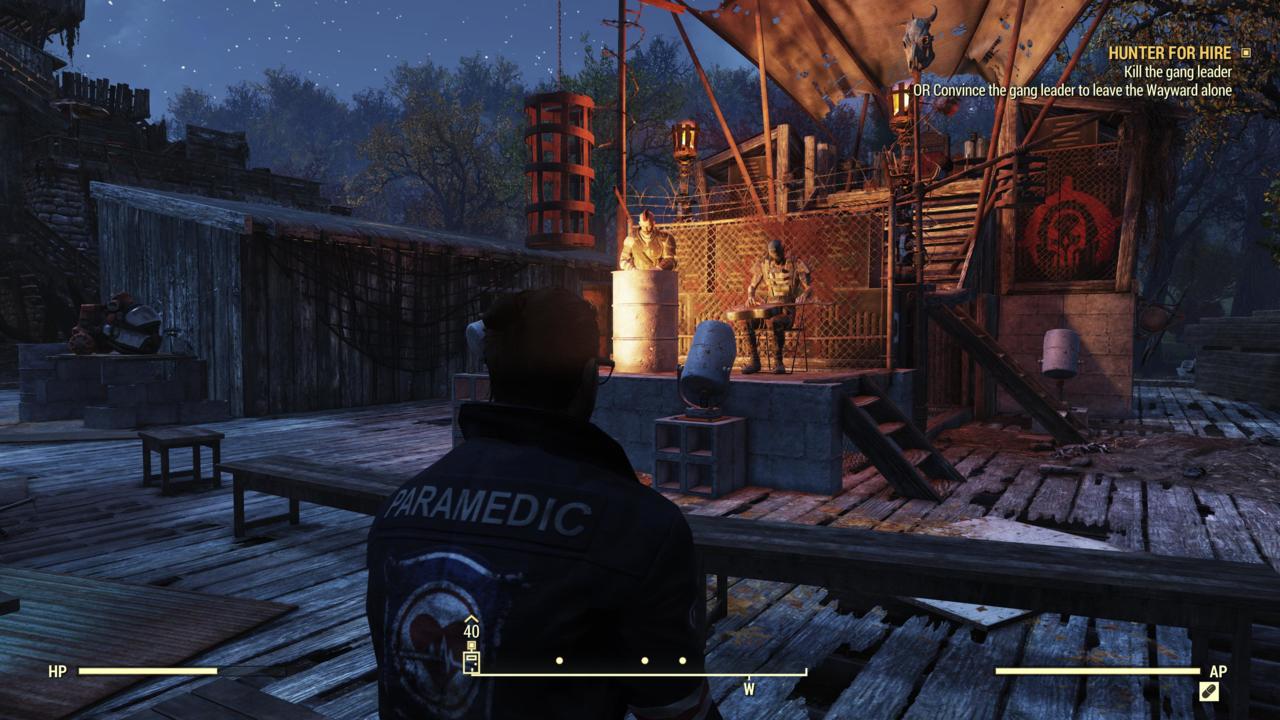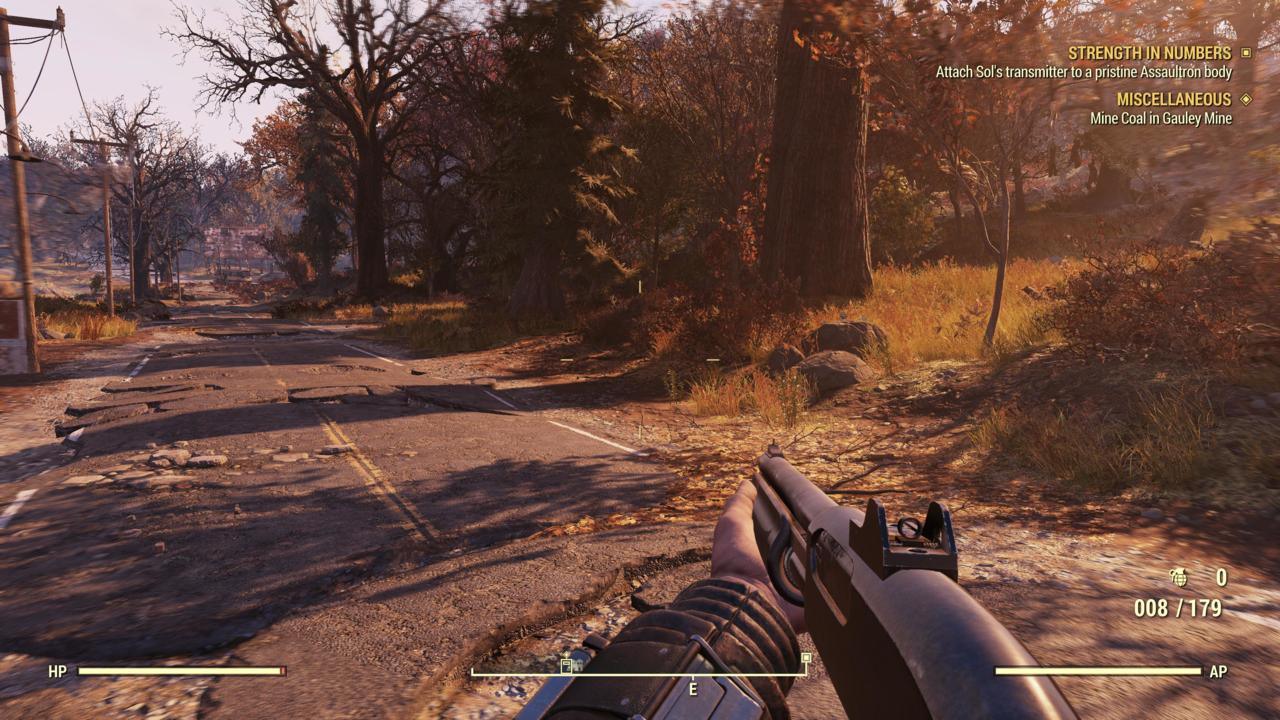Since its launch in late 2018, Fallout 76 has lacked one element crucial to the series’ identity. The series' best moments predominantly involved stories of its survivors, the poor souls unfortunate enough to have been exposed to nuclear war and the horrors of its fallout. Fallout 76's latest free expansion, Wastelanders, attempts to inject some of that humanity into the game by introducing human NPCs and their stories to the auburn hills of Appalachia, while also expanding upon available role-playing options. Taken as a separate part, Wastelanders represents some of the best Fallout content since New Vegas, but Fallout 76's flawed structure and mechanics prevent it from shining.
It's been more than a year since I played Fallout 76, and it's likely that I'm not the only one returning from a prolonged absence now that Wastelanders has launched. This made me decide to start a new character in a bid to see just how much Fallout 76 has changed since then. Wastelanders' changes are apparent from the start. After the tutorial, you emerge from Vault 76 to something new: Two human travelers, marking the prominent return of human life to West Virginia wasteland, greet you at the entrance to the vault. They mention a treasure rumored to be buried in the hills of Appalachia, which quickly leads you to a newly established bar under the management of Duchess and her party of ragtag brains and brawn. This alternative start to Fallout 76 is more gripping than the previous audio logs that initially introduced you to its world and serves to illustrate how Wastelanders' content affects the rest of the game.
Initial tutorial quests take you through the broad strokes of Fallout 76's survival elements and base-building, interspersed with contextual dialogue for each action delivered by a character you can actually interact with. The disembodied audio logs and impersonal robots of the original tutorial are still there if you choose a different route, but running through the same lessons while advancing a more captivating story in Wastelanders make Fallout 76's opening hours more akin to a traditional Fallout adventure. It can be easy for brand-new players to miss this pair of human NPCs entirely, but for returning players their mere existence will quickly draw you to their new introduction.
The most welcome change is the addition of Fallout's traditional nuanced dialogue and the associated decision trees. Using points that you pour into your SPECIAL stats (the range of role-playing traits including strength, charisma, perception, and more) you can instigate certain dialogue options that help you resolve situations in different ways. An early example featured an altercation between Duchess and a local gang of raiders. Instead of breaking up the hostile intrusion into her bar, I was able to use my character's Perception skill to spot and call out backup hiding behind the enemies, letting them resolve the imminent conflict without having to pull the trigger. If you've played Fallout 3 or New Vegas in the past, you'll be familiar with the system that Wastelanders uses here. Despite not iterating on a system that's over a decade old, it adds much-needed personality and space for role-playing in contrast to the rest of Fallout 76's quests.
It's disappointing then that after its initial handful of quests, Wastelanders forces you to reach level 20 before you're able to continue its story. This requires you to plunge back into Fallout 76's original main questline, which is also required to contextualize the rest of the expansion's story. The issue isn't so much the ham-fisted timeline trickery that you have to ignore for the story's events to make sense, but rather the older quest structures that you have to return to for an extended period. Wastelanders' opening teases you with the kind of structure and storytelling that made previous Fallout games so captivating, but you have to see yourself through at least 10 hours of tedious pre-Wastelanders quests just to get back to it.
The whiplash of this switch is jarring. Going back to quests primarily relayed through audio logs is deflating, and the diminished sense of role-playing is prevalent. If Fallout 76's original quests have been altered since launch, the effect isn't significant. Many quests are straightforward: Move to a waypoint, kill enemies, pick up a quest item, and repeat. The lack of dialogue and decision-making in between makes the repetition even more noticeable, and it quickly reminded me why I was bored with Fallout 76 to begin with. At its worst, it's incredibly frustrating. When robotic quest-givers attempt to poke fun at how you had to travel so far across the map just to end up having to make the return trip, it isn't funny; it just reminds you that Fallout 76 understands its shortcomings and makes you deal with them anyway.

Once you reach the required level, however, the most promising parts of Wastelanders are ahead of you. You'll form relationships with two factions as you decide on a way forward, giving you even more space to tackle dialogue with choices that have lasting ramifications. The two factions--a returning band of raiders and a docile settlement of engineers--work towards the same goals with different approaches. Siding with the Raiders, I was surprised to see a different take on the predominantly violent archetype from past Fallout stories. Meg, the group's leader, expressed a clear understanding of how past Raider behavior was counterintuitive to sustainability, but still retained the tough-as-nails attitude required to cut it in the dangerous wasteland. This depth of character extended to my favorite pair in the Raider crew: a brash and energetic girl named Ra-Ra and her best friend Gail, a tall and powerful Super Mutant. Listening in on their friendly conversations or their comical teardowns of other raiders made small pauses in their camp between missions worth it, making me look forward to each next interaction with the pair.
This characterization that Fallout 76 initially lacked wasn't just a hindrance to its overall world-building, but to its quests too. The later questlines in Wastelanders are fantastic, eschewing the reliance on combat and giving space to more variation. Whether it's deciding how to infiltrate a brutal underground fighting ring, tricking security systems using a mutant, or navigating deadly traps left by a ghoul in his misguided attempts to rid himself from Appalachia, Wastelanders' quests are consistently engaging, in spite of Fallout 76's enduring issues with its gameplay mechanics.
Wastelanders' quests are consistently engaging, in spite of Fallout 76's enduring issues with its gameplay mechanics
But for an online-only game, Fallout 76 still makes playing with friends one of its biggest hurdles to work around. When you're exploring the wasteland and taking on side quests, rotating public events, or just hunting for loot, playing with a party does make the monotony more enjoyable, but anything to do with main quests is still problematic. This is highlighted in Wastelanders' new narrative spaces--areas where Fallout 76 intends for you to make lasting story decisions. These can range from small indoor areas, like Duchess' bar, to larger dungeon-like encounters where major story missions take place. In a party, you're given two choices: Either each player completes them alone or follows whoever the party leader is, forfeiting all of the meaningful decisions to them. However, Fallout 76 doesn't make sharing these moments with your friends worth it, as progress is only awarded to the party leader. You'll either have to complete each mission multiple times for each player's story to progress or not play together all.
Playing Fallout 76, and by extension its Wastelanders content, alone is entirely possible, and it's how I spent most of my time. But it's also the most tedious way to play, as Fallout 76's many survival elements require considerable amounts of time and effort away from its more engaging aspects. Hunger and thirst meters drain rapidly and negatively impact both your action points and health, while weapon condition meters will routinely run their course and leave you without your favorite rifle in combat. You can sustain yourself with raw food and dirty water in large quantities (if you have the medicine to cure any diseases and radiation poisoning), but for the most part you have to cook food and boil water at a cooking station. Similarly, you have to spend a lot of time looking for junk to break down into pieces to repair weapons and armor.

Fallout 76 still has some eye-catching settlements and dilapidated factories to explore, but for the most part I was too fixated on hunting down junk to truly appreciate the stories they tell. A lot of my time in Fallout 76 revolved around its convoluted in-game menus, shuffling around from one tab to the next to administer healing items or diving into separate menus entirely to repair my gear. The upkeep is a frequent bother. Without any meaningful tension or satisfying challenge to overcome, being forced to consistently engage with these mechanics feels like little more than unnecessary roadblocks. You can purchase repair and salvage kits with real money from Fallout 76's store (I only found two in-game in 30 hours), and it does alleviate the tedium to an extent. But it's hard not to wonder, then, how much of the survival frustrations are designed intentionally to push you in the direction of spending even more money on microtransactions.
Fallout 76 retains a heavy emphasis on combat, and it's another facet that hasn't changed all too much since launch. Weapons still feel cumbersome to use, especially if you go the route of specializing in melee combat. VATS, the tactical body-part aiming mechanic from past Fallout games, still feels out of place since the world around you still can't be paused, serving more as an aim-assist that loses all semblance of its strategic roots. And the balance of combat is still incredibly confusing, with main quests presenting you with trivial encounters only to then thrust you into a scenario where enemies are almost immediately killing you. For such a large part of the overall gameplay loop, combat still remains one of Fallout 76's weakest elements.
For an online-only game, Fallout 76 still makes playing with friends one of its biggest hurdles to work around.
There are still numerous bugs and technical issues in Fallout 76, affecting not only new Wastelanders content but older questlines equally. Some are small and inconsequential enough to ignore, like clipping character models and floating supply crates. Others are more difficult to ignore. I encountered numerous quest bugs that brought my progress to a halt, forcing me to reboot the game and start the entire quest again. On Wastelanders' final quest, this happened three times at different points, which made what was meant to be a climatic heist into a frustrating exercise of hoping I'd reach the end of it. On top of that, Fallout 76 would routinely freeze and crash, as well as suffer severe frame rate issues and technical oddities like invincible enemies or freezing dialogue.
In many ways, it's Fallout 76's initial foundation that so severely holds it back from its most engaging content to date. Wastelanders is a clear return to more traditional and captivating Fallout stories, with characters and quests that give you room to role-play in a way the original quests lacked. But they still require you to dedicate a lot of time to survival mechanics that don't reward your effort, and its frequent combat remains monotonous and uninteresting. Wastelanders introduces some of the best Fallout sequences in recent years, but you'll have to dig through a lot of Fallout 76's enduring issues to experience them.



















